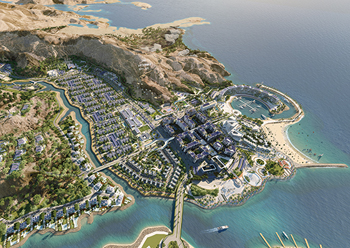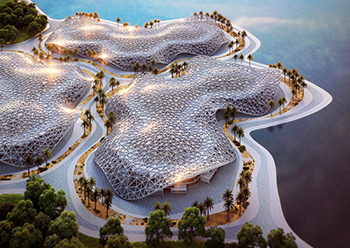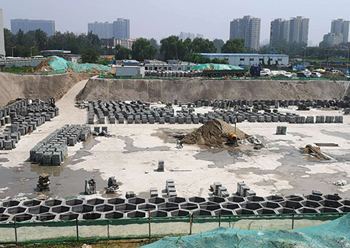
 Urban Tech District, proposed for Dubai, aims to become a living laboratory that promotes innovation and entrepreneurship in urban technology.
Urban Tech District, proposed for Dubai, aims to become a living laboratory that promotes innovation and entrepreneurship in urban technology.
The next generation of sustainable cities will be “empowering cities” that put people at the heart of development and promote an entrepreneurial spirit, fostering a bottom-up culture where innovators could help transform cities into more sustainable environments, says the founder of URB, a key developer that is looking at accelerating the world’s transition towards sustainable development.
“The current system for urban planning is essentially a top-down system and is usually initiated from the perspective of central decision makers and they tend to neglect the people at the bottom who have the best knowledge of the needs as well as the demands of the local areas. This system doesn’t encourage community involvement and leads to a waste of resources because there's a lack of understanding of the ground reality as each community will most likely have different needs,” says Baharash Bagherian, the CEO of URB.
The solution could be flipping this model and empowering people so cities focus on investing in young companies that offer innovative products or services in sectors such as health, water, agriculture or renewable energy that will have a huge impact on the next generation of sustainable cities, he says.
Bagherian was part of the team that designed various sustainable cities including The Sustainable City Yiti in Oman, The Sustainable City Yas in Abu Dhabi, The Sustainable City Amman and Phase 2 of The Sustainable City Dubai.
His company has unveiled the designs of a variety of projects that aim towards new zero communities that provide food, water and energy security. Three of these projects are at the concept masterplan stage and include the XZero City in Kuwait, Alnama City in Saudi Arabia and Nexgen Sustainable City in Egypt. URB has also proposed three projects for Dubai – Urban Tech District, which is at the concept design stage; Agri Hub, which is in the midst of concept design; and the most recently announced The Loop, for which research and development work is in progress.
The focus of these green cities has been introducing key planning principles that target sustainability at the early stages.
“Basic design decisions such as orientation, density and form provide the most environmental gains, yet these require the least financial investment. Thus, at the early stages of the project we are able to reduce a large amount of energy demand with little cost,” says Bagherian.
The projects were further optimised using various tools, methods and analysis such as energy modelling, microclimate analysis, solar radiation analysis, daylight simulations/analysis and glare control, water efficiency and recycling, lifecycle costing analysis, waste management and recycling analysis, sustainable landscaping and urban drainage analysis.
The resilient multifunctional landscape of the cities is designed to promote health, wellbeing and biodiversity, creating a vibrant social neighbourhood whilst connecting residents to all amenities within minutes.
The green spine that wraps the cities is integrated with a network of biophilic systems which allow nature to thrive whilst promoting resilience through various strategies. A green industrial hub and future expansion zone are located within the green spine.
Scalable food, energy and water farms, bioswales, planter boxes, rain gardens, permeable pavements, green roofs, efficient zero-waste management system are all fully integrated and are just some of the multifaceted solutions that will work together as a complete network to create the most resilient cities on Earth, he says.
The planning of the cities was optimised to limit vehicular access thus maximising the landscape ratio, to create walkable cities.
 |
|
XZero in Kuwait will provide food and energy security whilst promoting a green circular economy in an eco-friendly live, work and visit destination. |
XZero
XZero aims to provide a net zero carbon lifestyle for 100,000 residents, in balance with nature. Unveiled last year, the 16-sq-km development is planned for southern Kuwait with a view to offering 30,000 residential units, as well as 30,000 green jobs, which will be created in various hubs dedicated to sectors such as medical, tourism, technology, educational, retail and entertainment.
The city will provide food and energy security whilst promoting a green circular economy in an eco-friendly live, work and visit destination.
XZero will promote sustainable tourism through its various eco-friendly hospitality assets, including a five-star eco resort and eco lodges. Edutainment attractions such as a utility park and nature conservation centre will transform the city into a unique visitor attraction, according to URB. The medical hub will feature an autism village, wellness centre and clinics. The educational hub will feature a nursery, school and an institute. The commercial hub will include indoor mall and flexible office spaces.
The city will feature 35 km of dedicated running and cycling tracks as well as 9 km of equestrian track which connects to the equestrian centre.
 |
|
Alnama is designed to be a smart zero carbon destination in Riyadh. |
Alnama
Derived from the Arabic word “Alnama” which means “thrive”, it is designed to be a smart zero carbon destination that has been proposed to occupy a 1,000-hectare site in Riyadh. The city will promote sustainable living in a 10-sq-km community with various hubs for residential, educational, commercial, tourism and medical services.
The city is planned to provide 11,000 residential units for a population of 44,000 people, while creating 10,000 jobs in various sectors including green-tech industries.
The various hubs will transform the city into a unique destination as well as an attraction for ecotourists and medical tourists. The green-tech hub will provide an innovative ecosystem for urban-tech companies related to food, energy, water, waste, mobility and building materials.
Eco-friendly glamping lodges, eco resorts as well as a nature conservation centre are key components of the hospitality hub, which will promote ecotourism. An autism village, wellness centre and clinics within the medical hub will drive medical tourism.
The city provides 37 km of dedicated running and cycling tracks which are integrated within the landscape design. A dedicated 7.5-km loop of equestrian track also connects with the equestrian centre.
Nexgen sustainable city
Nexgen in Egypt aims to become the world’s first ‘climate-positive’ city producing more energy and food than it consumes. Planned for the eastern district of Cairo, the 580-hectare sustainable city will provide 9,000 residential units for a population of 35,000 residents. The project will create 10,000 jobs with the majority focusing on green-tech industries related to food, energy, water and waste, thus creating a circular green economy for the city, says URB.
The city features 11.5 km of dedicated running and cycling tracks which are integrated within the landscape design. A dedicated 2.4-km loop of equestrian track also connects with the equestrian centre.
 |
|
The Agri Hub aims to transform Dubai into an agritourism destination. |
Agri Hub
The Agri Hub aims to transform Dubai into the world’s largest agritourism destination, creating more than 10,000 jobs and promoting a green economy. Planned to be located in Dubai’s desert, the project will promote a new agritourism experience, whilst offering fun and adventure as well as amenities.
The new hub will feature a nature and heritage conservation centre, ecotourism centre, an agri-tech institute and a restorative wellness centre.
The Loop
URB has also proposed a new 93-km sustainable urban highway which aims to become the smartest cycling and running infrastructure anywhere in the world.
 |
|
The Loop, a climate-controlled walking and cycling environment proposed for Dubai. |
The Loop project in Dubai will become the first active mobility infrastructure of its kind anywhere in the world, with various amenities and sustainability features that will shape the future of urban mobility in Dubai and beyond, says the developer.
The Loop aims to connect more than 3 million residents using a healthy mode of transport, to key services and locations by walking and cycling within minutes. It will provide an enjoyable climate-controlled all-year environment, to make walking and cycling the primary mode of transport for Dubai’s residents, in line with its new 20-minute city initiative.
Urban Tech District
Urban Tech District, proposed to be located on the creekside of Al Jaddaf area in Dubai, aims to become a living laboratory where innovation and entrepreneurship in urban technology come together to thrive.
“The Urban Tech District will be a new global tech hub for urban innovation. With a total of 140,000 sq m of built-up area, it will be the world’s largest urban tech district,” Bagherian says.
The district will enable the growth of urban-tech solutions at a much larger scale, as well as provide investment opportunities to innovators that are tackling some of the most critical issues related to sustainable cities.
The district will also be home to the urban tech institute, which will foster the next generation of urban tech leaders.





















_0001.jpg)


.jpg)
















.jpg)








.jpg)



